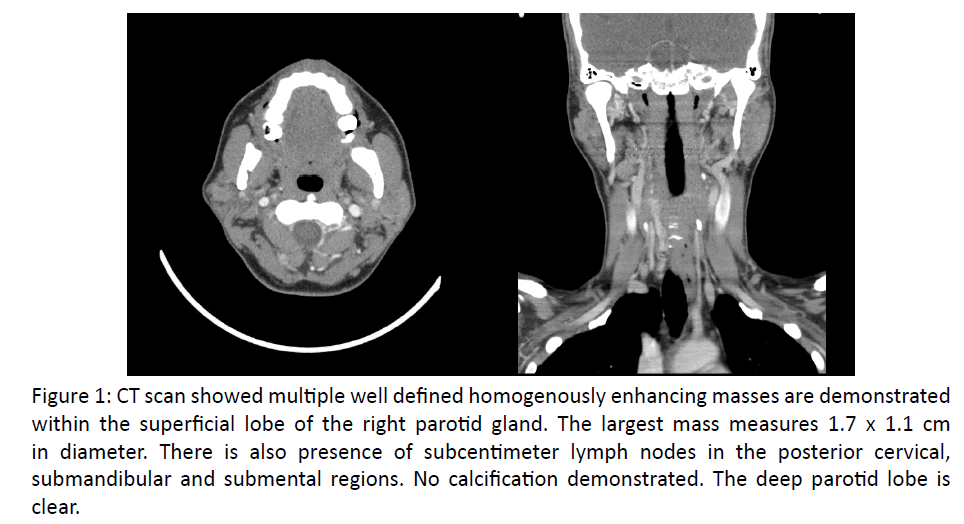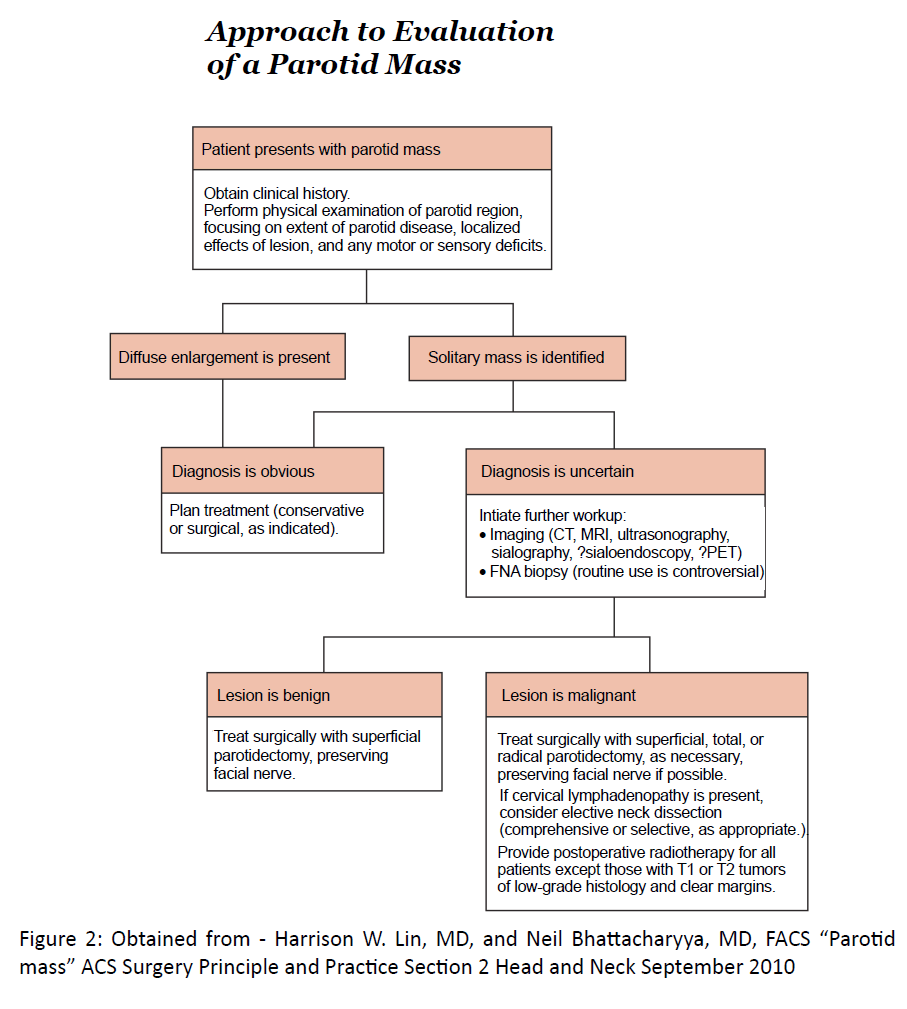Case Report - Otolaryngology Online Journal (2016) Volume 6, Issue 2
Acinic Cell Carcinoma of the Parotid Gland: Case Report
- *Corresponding Author:
- Shi Nee Tan
Department of Otorhinolaryngology, KPJ University College, Malaysia
E-mail: psychodynamic.snt@gmail.com
Received: March 10, 2016; Accepted: April 05, 2016; Published: April 08, 2016
Abstract
Acinic cell carcinoma (ACC) is a rarest form of low-grade malignant salivary neoplasm in which the predominant site is the parotid gland and women are usually more frequently diagnosed than men. Surgical excision is the main treatment of this malignant neoplasm. Other treatment modalities such as radiotherapy may be indicated in some cases. I present a case of 46 years lady who present with slowly enlarging right parotid mass and confirmed to be acinic cell carcinoma by pathology.
Case report
My patient, 46 years, Malay lady no known medical illness who presented to head and neck surgery clinic with right parotid swelling of a year duration, insidious in onset and progressive in nature.
On examination, the patient had a firm to hard multilobulated swelling over right parotid gland which was tender measuring 3 cm x 3 cm. Facial nerve function was intact. The rest of head and neck examination was normal. A pre-operative CT scan of right parotid mass was suggestive right intra parotid mass involving the superficial lobe measuring 5 cm x 4 cm x 1.5 cm (Figure 1). She then underwent superficial parotidectomy with preservation of facial nerve. The multilobulated mass measures 4 cm x 3 cm x 2 cm and was well encapsulated at the superficial lobe of the right parotid gland. Deep lobe appeared normal.
Figure 1: HPLC chromatogram of the nine reference compounds in 50% aqueous methanol, measured at 370nm. Retention times for rutin, sutherlandin A, sutherlandin B, kaempferol-3-O-rutinoside, sutherlandin C, sutherlandin D, quercitrin, quercetin and kaempferol were 11.9, 12.7, 13.8, 15.3, 16.2, 17.0, 18.0, 26.2 and 28.1 minutes, respectively.
The post operative histopathological report revealed acinic cell carcinoma with margin of the cells clear. She is then follow-up by the oncology specialist and planned for radiotherapy.
Discussion
There are many types of salivary gland cancers. Acinic cell carcinoma is the fourth most common malignant parotid gland tumour after mucoepidermoid carcinoma (MEC), adenoid cystic carcinoma (AdCC) and carcinoma ex pleomorphic adenoma [1].
I present with this, a case report where incidental results detected by histopathology examination with acinic cell carcinoma of the parotid gland which is a rare entity of parotid tumour. It was initially thought to be benign disease entity and Foote and Frazell [1,2] first coined it as a carcinoma in the early 1950s [1-3].
Most acinic cell carcinomas are low-grade and are associated with less aggressive growth and good survival rates (about 70% at 10 years) [4,5]. The female to male ratio is 1.5: 1 and the tumours usually occur in the fifth and sixth decades of life [3].
The cause of acinic cell carcinoma is unknown as little or no research has been done in this area [6,7]. Probably it has to do with multiple factors, including environmental and genetic. Possible causes that have been cited in the literature are: 1) a familial predisposition in parotid cancer, 2) chronic wood dust inhalation in certain individuals who develop minor salivary gland adenocarcinomas of the nasal and paranasal sinuses. Another possible carcinogen related cause is second-hand smoke. The potential causes listed are theoretical and anecdotal only. They have been implicated in other cancers, but not ACC specifically [7].
Presentation is usually with the common symptom of infra-auricular mass. Facial palsy or pain usually may not exist at the first time (Figure 2).
The possible differential diagnosis can be divided into non neoplastic and neoplastic conditions which include neoplastic lesions, congenital, vascular malformations, acute and chronic cervical lymphadenopathies and cystic lesions [8-10].
Radiological and cytological investigations may be beneficial in specifying this diagnosis.
Surgery is often the primary treatment which is the preferred method of treatment for salivary acinic cell carcinoma. However, it has not been established if removal of the entire gland is preferred or if it is better to attempt to remove only the cancerous tissue. Post-operative radiation therapy may be recommended to attempt to kill any cancer cells that may have been missed by the surgeon. Debate continues regarding the extent of resection needed, as well as the role for neck dissection and adjuvant radiotherapy [7,11,12].
In my case, a superficial parotidectomy was done. Patient was then subsequently referred for radiotherapy. Nevertheless, follow up of the patient did not show any mass, recurrence or metastasis. However, a further case studies and long term follow up is indicated for further documentation.
Conclusion
Acinic cell carcinoma is the low grade malignant salivary neoplasm rarely diagnosed in salivary gland which may be overlooked. The overall prognosis after the surgical resection depends on extent of lesion and adequacy of initial resection. Careful long term follow up protocol is advised in view of its malignant potential. It requires a high index of clinical suspicion, prompt diagnosis and definitive initial surgical treatment. If the condition is appropriately dealt with from the beginning, its morbidity is extremely low and permanent cure is highly probable.
References
- Dabrowski J, pietka T, przybysz J, krzymanski G(2011) “Acinic cell carcinoma of parotid gland. A case report” Contemporary Oncology 15: 47-50.
- Foote FW Jr, Frazell EL (1953) “Tumors of the major salivary glands.” Cancer 6:1065-133.
- Wonjae Cha, Min-Su Kim, Jae-ChulAhn, WoongsangSunwoo SW, Myeon Song C, Kyun Kwon T, Sung MW, Hyun Kim K (2011) MD “Clinical Analysis of Acinic Cell Carcinoma in Parotid Gland”Clinical and Experimental Otorhinolaryngology 4: 188-192.
- Anthony C Nichols, Chan-Seng-Yue M, John Yoo, Agrawal SK,Starmans MHW(2013) “A Case Report and Genetic Characterization of a Massive Acinic Cell Carcinoma of the Parotid with Delayed Distant Metastases” A Case Reports in Oncological Medicine, Article ID 270362, 7 pages.
- Roberto Oliveira L, Figueiredo Soave D, da Costa JPO, Ribeiro-Silva A (2010) “Acinic Cell Carcinoma of Parotid Gland: Report of Three Cases and Literature Review” Revista Portuguesa de Estomatologia, MedicinaDentária e CirurgiaMaxilofacial 51: 5-11.
- (2010) American Joint Committee of Cancer “Major Salivary Gland” AJCC Cancer Staging Manual 7: 79-82.
- Alexander Delides,George Velegrakis, George Kontogeorgos, EvangeliaKaragianni, DimitrisNakas, Emmanuel Helidonis (2005) “Familial bilateral acinic cell carcinoma of the parotid synchronous with pituitary adenoma: case report” Wiley InterScience
- Chiara Bianchini, Andrea Ciorba, Francesco Stomeo, Stefano Pelucchi, Massimo Pedriali, Antonio Pastore (2011) “A case of parotid acinic cell carcinoma in a young boy” Braz J Otorhinolaryngol77:402.
- John Han-Chih Chang, Kenneth Blank (2001) MD “Acinic Cell Carcinoma of the Salivary Gland”.
- Samuel R Greig, Chaplin JM, Mcivor NP, Izzard EM, Taylor G, Wee D (2008) “Acinic cell carcinoma of the parotid gland: Auckland Experience and Literature review” ANZ J Surg 78: 754-758.
- Gita jayaram, MaizatulAsiah,Muthu Kumar,Gopalakrishnan (2002) “Papillary cystic type of acinic cell carcinoma of parotid: fine needle aspiration cytological features of a high grade variant with oncocytic metaplasia” Malaysian J Pathol 24: 107-112.
- Harrison W Lin, Neil Bhattacharyya (2010) “Parotid mass” ACS Surgery Principle and Practice Section 2 Head and Neck.

